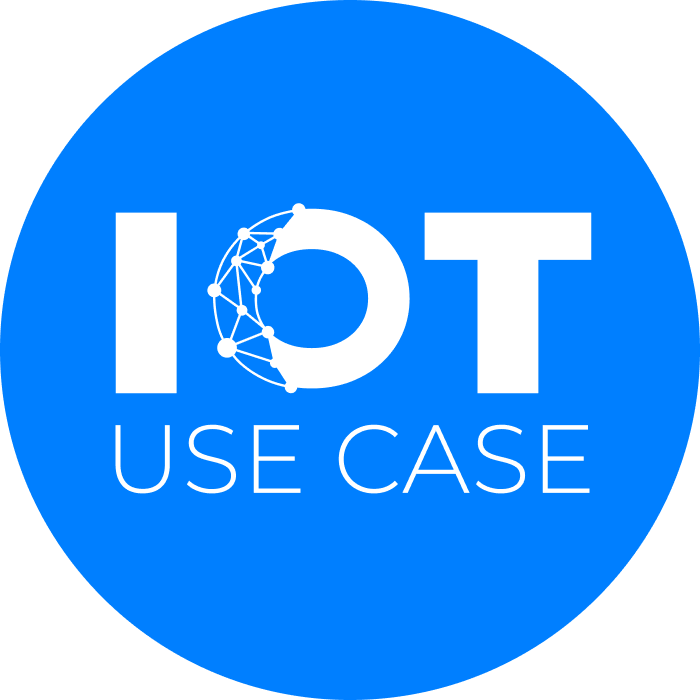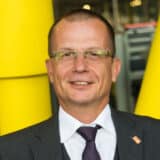In the 144th episode of the IoT Use Case Podcast, host Ing. Madeleine Mickeleit speaks with Richard Habering, Head of the smart plastics Business Unit at igus. The focus is on predictive maintenance for energy chains in container ports and how data-driven predictions, using sensors and algorithms, help prevent unplanned downtimes.
Podcast episode summary
In this episode, we dive into the world of predictive maintenance for energy chains – a critical component in modern industrial systems. Smart sensors and intelligent algorithms continuously monitor the condition of these chains, helping to prevent failures before they happen.
A key practical example comes from container ports, where crane downtimes are extremely costly. Richard explains how igus energy chains are equipped with sensors that check for anomalies in real-time, allowing companies to avoid unplanned outages. The challenges of implementing IoT solutions and the often hesitant acceptance at the production level are also openly discussed.
In addition to fascinating insights into real-world applications, Richard shares his lessons from three years of IoT experience at igus and explains the role of artificial intelligence. He will also explain how AI-supported evaluations can help to further improve maintenance strategies. #superwise The Superwise system is a smart maintenance solution from igus that combines intelligent sensor technology with the internal CRM to enable proactive maintenance measures.
This episode makes it clear: Predictive maintenance is no distant future concept—it’s already a reality, providing companies with significant advantages in terms of efficiency and cost savings.
Podcast interview
Today, we’ll be discussing the use case of Predictive Maintenance, and as always, we’ll be looking at a real-life example from one of our customers. Today’s focus is on the maintenance of energy chains and how to prevent unplanned downtime in container ports. The technology we’ll be talking about uses data-driven predictions through sensors and algorithms to monitor the condition of devices and machines and detect anomalies early on.
For this, I’ve invited Richard Habering, the Head of Business Unit smart plastics at igus. igus is a global leader in energy chain systems and polymer plain bearings. We’ll be discussing the new IoT solutions at igus, the key learnings Richard has gained from three years of IoT experience at igus and with customers, and the role AI plays in IoT data. You’ll hear all about it today.
You can find all the information about the discussed examples, as always, in the show notes or at www.iotusecase.com. By the way, if you’re listening to this episode on Spotify, the comment and survey feature is now available for you. You can find it directly below the episode description. Feel free to leave a comment or answer the survey, and I’ll address it in the next episode.
So, let’s head into the podcast studio – let’s go!
Hello and welcome, Richard, great to have you with us today and welcome to the IoT Use Case Podcast. How are you, and where are you joining us from?
Richard
You’re catching me at the Frankfurt Airport lounge, about to head to Asia to promote the smart plastics superwise initiative. It’s not my first trip, and there’s a lot going on right now.
For the listeners: You always catch Richard on the move. You’re practically a veteran at igus when it comes to IoT, you know all the customers and are constantly on-site. The last episode we did was on February 22, 2023. I’m excited to hear what’s new, and today we’ll also be discussing a specific use case.
The last episode is still relevant—great customer case—check it out, Episode 88. But Richard, for those who don’t know you yet, can you briefly introduce yourself and tell us what you do at igus?
Richard
I always take on the projects at igus that nobody else wants. In 2018, I took over the smart plastics initiative. smart plastics at igus means that our plastic products, such as plain bearings, special cables, and energy chains, communicate electronically with the customer. There are various concepts, but essentially, I’m the electronics guy who connects plastic products to electronics hardware and the internet.
Nice. I think everyone knows what a bearing is, but not everyone is familiar with energy chains or cable carriers. I was reminded of Episode 88, where you had a great case with a train washing facility operator. These energy chains guide the cables in such facilities, which are often dirty and exposed to harsh environmental conditions.
Richard
You can think of an energy chain as a flexible cable duct. If you cut a plastic cable duct into many small pieces and connect them in a way that they move like a chain, you get a solution that perfectly guides and protects cables to moving parts of the system.
You can see this next time you’re in a car wash: Look to your right, where the bridge moves over your car. That bridge needs power, water, and data connections. To the right, you’ll see a black plastic chain running along a track, guiding the cables and lines from a fixed point on the wall to the moving portal of the car wash, which moves back and forth over your car.
Take a look next time, or just visit the website:
Richard
www.igus.de or www.igus.eu. For our topic, just add /smartplastics to go directly to my page.
Exactly, smart for smart plastics. You already mentioned that your products are being connected. Is there a dedicated IoT business unit that handles this connectivity? Are you extracting data from bearings and energy chains to create added value for your customers?
Richard
Sort of, but what you’re describing is the classic approach: attaching sensors, collecting a lot of data, interpreting it, and generating value for the customer. We were lucky enough to approach the topic from a different perspective. Our plastic products are extremely durable, but wear typically shows up as abrasion. This means that the plastic parts wear down, and we assess this wear condition. We benefit from over 15 years of experience in the largest test lab for dynamic energy transmission systems in Cologne. Based on this data, we’ve developed algorithms and have been offering our customers a lifetime calculator for over 15 years, allowing them to estimate the lifespan of their plastic products based on application parameters. These algorithms have proven to be highly reliable—sometimes a bit conservative, but always precise. So, when we know the product and the dynamic application data, we can predict its theoretical lifespan quite accurately. From there, we only need a few sensors to compare the theoretical prediction with reality and get feedback from the system.
I understand. Before we dive into specific use cases—you’ve brought an example with you—I’d like to ask: You’ve been working in this business unit for several years and have encountered many use cases with customers. What challenges have you seen in the implementation of IoT solutions over the past two years? Could you share some insights with us?
Richard
In 2016, 2017, and 2018, buzzwords like IoT, digital twin, cloud solutions, and predictive maintenance were everywhere. Many people were talking about them, and we also started exploring these areas—testing sensors, developing our own, and uploading data to the internet through aggregators. We worked on data analytics in the cloud, created dashboards, and were able to offer early lifetime predictions and basic anomaly detection. However, we also went into the field to develop applications together with customers. To be honest, for 90 to 95 percent of our customers, the topic hasn’t really arrived yet. In large corporations, there are people thinking about predictive maintenance, but at the production level—among maintenance staff, facility managers, and production supervisors—predictive maintenance is still far from being a reality. And when it comes to the internet, things get really tricky. People order pizza online, do internet banking, spend their hard-earned money online, and do many other things on the internet, to keep it PG here. But connecting their machines to the internet? That’s a step too far for many. For most people in production, IoT is still far from being part of everyday operations.
You also have customers where IoT solutions are already working. What has been your experience with these customers, where real value is being generated? Could you give us examples of customers who are willing to move in this direction to avoid downtime for example?
Richard
A major shift in thinking occurred during the COVID period. Many realized how complicated things could get if the maintenance technician couldn’t be on-site or if the component manufacturer couldn’t send a technician because flights or trains weren’t running. What can you do online in such a situation? COVID actually helped us in this regard. Thanks to our technology, which works not only online but also on-premise in the control cabinet, we were able to offer solutions. Critical infrastructure, like ports, container handling, and bulk handling, where downtime can lead to huge costs, quickly adopted IoT solutions. Did you know that a container ship often decides mid-voyage which port to dock at based on unloading times and costs? If it arrives late, penalties are incurred. Now, imagine if one of the large cranes unloading the containers breaks down—it costs both time and money. A ship often carries 23,000 containers, and every crane that fails significantly extends the unloading process. That’s where it really hurts.
[12:09] Challenges, potentials and status quo – This is what the use case looks like in practice
Let’s stick with the example from the port or logistics sector. Can you give us a specific example of a customer using your products in this environment, and explain how a failure occurs?
Richard
The trolley that moves back and forth, carrying the containers, has massive motors that consume as much power as a small village. The cables that supply these motors are several centimeters thick, and the trolleys move extremely fast, up to four meters per second, over a distance of 130 meters. There are many external factors that can cause issues, from weather conditions like rain, snow, and ice to more unusual things, like dead birds. An 80-kilogram albatross in an energy chain is no joke. Humans can also accidentally cause damage during maintenance. When these external influences pile up, an energy chain can break. This is where it gets interesting: if you can predict the breakage, you’re engaging in predictive maintenance. But even if you detect the breakage and immediately stop the crane to repair it quickly, it’s still better than letting the system continue running and causing more significant damage.
So otherwise, a ticket would probably have been opened in your service department, where a customer says, “The crane is down, we need help, we need spare parts.” What does the traditional process look like so far?
Richard
Ticket is a nice modern word for the panic that arises in such situations. It’s not just one person calling; many people start calling. It escalates, materials have to be assembled, delivered, and installed. We have our own service teams and work with partner companies. But when an energy chain crashes, it’s the worst-case scenario. This is no simple ticket, it’s full-on panic. We aim to prevent this panic by reacting quickly and avoiding total damage. Even better is predicting when something is about to go wrong. Many technical problems show warning signs beforehand, and that’s what we’re trying to identify through predictive maintenance.
How would you detect something like that? You have a large research and development department in Cologne. Are these deviations in specific metrics, or are there different scenarios? Can you give us an example?
Richard
There are many factors. Let’s talk about condition monitoring: One indicator for the operation of an energy chain is the force required to move it. You can imagine 100 meters of chain stacked on top of itself, which requires some force to push it back and forth. If that force suddenly spikes, it means something is in the way. We install a load cell, a sensor that measures the force at the puller. If the force increases quickly, we switch off immediately so that little or no damage is done. The sensor continuously generates data too, and the force has patterns and changes over time. We interpret this data to create predictions—like where the chain is in its lifecycle, and whether something is slowly changing so we can intervene early. But this is just one indicator; we have other methods as well, though we keep some of those trade secrets to ourselves.
It probably depends a lot on the use case, right?
A crane is one example, but surely there are different requirements depending on the equipment.
Richard
No, the tensile and shear force is a universal indicator for any sliding energy chain, whether for a crane, a gantry or a waste incineration plant. Problems can occur anywhere, and the sensor technology, in conjunction with the theoretical lifespan, helps evaluate the condition and wear of the energy chain. How exactly that works, we’ll keep to ourselves, of course.
Right, that’s the algorithm. You measure pull-push force in an energy chain. What would it be for a bearing? That’s also interesting, as bearings are used everywhere. What is the indicator there?
Richard
In the condition monitoring of a bearing, it’s not about forces. Bearings change over time due to wear, and this wear alters the geometric structure of the bearing. These changes can be measured relatively easily without having to rely on vibrations or acoustic signals – it’s the geometric dimensions that external sensors can detect.
Very interesting. To everyone listening: Feel free to message me on LinkedIn and let me know about the use cases you’re working on. Do you have applications with plain bearings, energy chains, linear guides, or electric motors? Maybe we can schedule another session with Richard to discuss your use cases. But back to the topic. When it comes to implementation, you’ve mentioned several modules. Here’s a question: Do your customers already have this data, especially in highly automated environments like ports? Do you integrate into the existing IT infrastructure, or do you gather the data directly from your devices?
Richard
For large cranes, we actually install an on-premise device in the control cabinet to collect our data. This device also generates the predictions, assessments, and maintenance recommendations. It’s a small module that we call i.Cee – essentially, it’s a Linux computer that handles all of this.
For the customer we’re discussing, we started with condition monitoring and generating predictive information. It took a lot of effort to integrate this information into the customer’s existing monitoring system, but it’s technically feasible through JSON files, MQTT Broker, REST API, or OPC UA. This way, the customer application regularly receives sensor data, recommendations, and lifespan information, which are displayed in the customer’s system, for example, as a yellow triangle in the control room. It looks like an airport tower, where all the cranes are monitored. When a component sends out a warning, the yellow triangle blinks, and you can check what’s going on. While critical components like main drives and brakes are often monitored, energy chains have hardly been on anyone’s radar—although they are essential because without them, the crane stops. This awareness has changed recently.
I’ll link the use cases Richard mentioned in the show notes. igus has many exciting examples, showcasing energy chains, cables, and high-performance bearings for long operational life in crane systems, as well as many other use cases. Be sure to check them out—they’re really interesting. Richard, you also mentioned your i.Cee module, I’ll include a link to that as well. It’s truly innovative what your products are doing there..
[22:12] Results, Business Models and Best Practices – How Success is Measured
What are your best practices for implementing such projects? What should people be especially careful about, and what pitfalls or recommendations do you have?
Richard
A key topic is integration into the customer’s MES, SCADA, or crane monitoring systems. One customer asked me after we integrated the data into their system: “Do I need to become an energy chain specialist now to interpret these sensor readings? You’re the experts, why don’t you just call me?”
That was a turning point for us. That was a turning point for us. Why not connect the sensor data, predictions, and maintenance management directly with the customer’s system, and also link it to our internal system? This way, we can proactively inform the customer. For example, the on-site maintenance technician didn’t even know a chain had been damaged until we called to notify them—someone had accidentally damaged the system with a forklift. We aim to enable this quick response by integrating into the customer’s system and connecting it with our internal Sales Information System. This way, we can provide the customer with the necessary information in time. Normally, when something goes wrong, it’s almost too late. But if we’ve already prepared everything and the system is running, we can react proactively. That’s what’s new, and we call it “superwise.” We always come up with creative names for our products. Superwise is basically the “super wise” solution for the customer, offering them an after-sales add-on that assures them: “Don’t worry, we’ve got it under control.” If something happens, the customer doesn’t call us; we call them. That’s the big innovation here.
Yes, this is really an exciting development in the service and after-sales sector. You’re real pioneers with use cases that provide clear business value to customers. It’s impressive that you’re combining service with data and providing maintenance and service technicians on-site with a powerful tool. The fact that igus proactively contacts customers when something happens is a true game changer It’s great to see that you already have concrete customer cases where this is working. Especially with critical applications like cranes, the return on investment is huge—when a crane goes down, the costs can escalate quickly.
Richard
Exactly, time is critical.
Thank you, Richard. I now understand which use cases you can implement and how your new products from the smart plastics area work. You’re the contact person, so if anyone has similar cases or just wants to exchange ideas, I’ll include your contact information in the show notes. Feel free to reach out to Richard.
I have one more question, since you talked a lot about data analysis and evaluation. What about AI? You briefly mentioned it earlier. How relevant is AI in IoT, and how is igus advancing in this area?
Richard
AI in this field is rather unspectacular. Of course, AI algorithms help link experiences from other systems, combine different indicators, and generate useful alerts. That’s become part of our daily routine. Whether with AI or human intelligence, the goal remains the same: avoiding unexpected downtime and extending product lifespan.
Check them out to learn more about igus’ latest developments in AI. Thank you again, Richard, for being with us today. And thanks for sharing your insights. I’ll give you the last word.
Richard
I hope it came across: sensor technology, IoT, predictive maintenance—none of this is rocket science. It’s something that can be used in daily operations to avoid unplanned downtime. The exciting part is figuring out which level of technology works best for the customer. And honestly, it’s really fun to tinker with it, get your hands dirty on-site, and work with the technology. The best part is the feedback from the customer when it works. Hopefully, more customers will discover predictive maintenance and IoT for themselves. We’re ready and excited to meet you—maybe at a trade show or directly at your facility.
Thanks again, Richard. Have a good flight and a great rest of the week. Bye.
Richard
Thank you. Bye, Madeleine.










